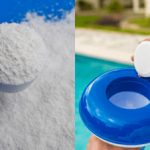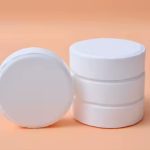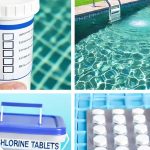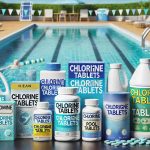Chlorine tablets are a common and effective method for keeping swimming pools clean and free from harmful bacteria. However, handling and storing these tablets require careful attention to safety due to their chemical properties. This article will provide essential safety tips for handling chlorine tablets, including proper storage, protective gear, and first aid measures in case of accidental exposure. Whether you are a pool owner or a professional pool maintenance worker, understanding these safety measures is crucial for preventing accidents and ensuring a safe environment.

Proper Storage of Chlorine Tablets
1. Use Appropriate Containers
Chlorine tablets must always be stored in their original, airtight containers. These containers are specifically designed to protect the tablets from moisture and environmental exposure, which can cause them to deteriorate or react prematurely. Ensure that the container is tightly sealed after each use to maintain the integrity of the tablets. If the original container is damaged or lost, transfer the tablets to another airtight, chemical-resistant container that is clearly labeled. Always refer to guidelines provided by the chlorine tablets manufacturer for proper storage instructions.
2. Store in a Cool, Dry Place
It’s essential to store chlorine tablets in a cool, dry place to prevent them from breaking down or reacting. Ideal storage conditions are away from direct sunlight, heat sources, and any area that could experience temperature fluctuations. Prolonged exposure to heat can cause the tablets to decompose, release harmful gases, or even become a fire hazard. A well-ventilated storage area is also crucial as it helps disperse any fumes that might escape, reducing the risk of inhalation and maintaining a safer environment.
3. Keep Away from Incompatible Materials
Chlorine tablets should be stored away from all incompatible materials, including flammable substances, acids, organic materials, and any other chemicals that might react with chlorine. Mixing chlorine with these substances can trigger dangerous chemical reactions, potentially resulting in fires, explosions, or the release of toxic fumes. Create a designated storage area specifically for chlorine tablets, ensuring it is isolated from any incompatible materials. Clearly label the storage area and containers to avoid accidental mixing or improper storage. Additionally, never store chlorine tablets near equipment that could potentially ignite or react with them, such as machinery that produces heat or sparks.
Protective Gear for Handling Chlorine Tablets
1. Wear Gloves
When handling chlorine tablets, always wear chemical-resistant gloves. Direct contact with chlorine can cause skin irritation or chemical burns. Gloves provide a protective barrier to keep your hands safe.
2. Use Eye Protection
Splashing or dust from chlorine tablets can cause serious eye injuries. Wearing safety goggles or a face shield can protect your eyes from accidental exposure.
3. Wear a Mask
Inhaling chlorine dust or fumes can irritate the respiratory system. Use a mask or respirator when handling or pouring chlorine tablets to prevent inhalation of harmful particles.
First Aid Measures for Accidental Exposure
1. Skin Contact
If chlorine tablets come into contact with your skin, immediately rinse the affected area with plenty of water. Remove any contaminated clothing and continue rinsing for at least 15 minutes. Seek medical attention if irritation persists or if you develop a rash or burns.
2. Eye Contact
In case of eye contact with chlorine, rinse your eyes with clean water for at least 15 minutes, keeping your eyelids open and moving your eyes around to ensure thorough rinsing. Seek medical attention immediately, even if the irritation seems mild.
3. Inhalation
If you inhale chlorine fumes, move to fresh air immediately. If you experience difficulty breathing, dizziness, or other symptoms, seek medical attention. Use a respirator to avoid inhaling fumes during handling.
4. Ingestion
If chlorine tablets are accidentally ingested, do not induce vomiting. Rinse your mouth with water and drink a small amount of milk or water if you are conscious and able to swallow. Seek medical attention immediately.
Additional Safety Tips
1. Read and Follow Manufacturer Instructions
Always read and follow the manufacturer’s instructions on the chlorine tablet packaging. These instructions provide important information on safe handling, storage, and disposal.
2. Label Storage Areas Clearly
Ensure that storage areas for chlorine tablets are clearly labeled and that all users are aware of the hazards and safety precautions associated with chlorine.
3. Keep Out of Reach of Children and Pets
Store chlorine tablets in a location that is inaccessible to children and pets. The tablets can be highly toxic if ingested, and accidental exposure can be dangerous.
4. Dispose of Chlorine Tablets Properly
Do not dispose of chlorine tablets in regular trash or down the drain. Follow local regulations and manufacturer guidelines for proper disposal to prevent environmental contamination and accidental exposure.
Conclusion
Handling and storing chlorine tablets safely is essential for maintaining a clean and safe swimming pool environment. By following these safety tips, including proper storage practices, using protective gear, and knowing first aid measures, you can minimize the risks associated with chlorine tablets. Always prioritize safety to ensure a healthy and enjoyable swimming experience for everyone. By understanding the correct procedures for handling pool chemicals, you can effectively maintain your pool while ensuring safety and compliance with guidelines provided by chlorine tablets manufacturers.





